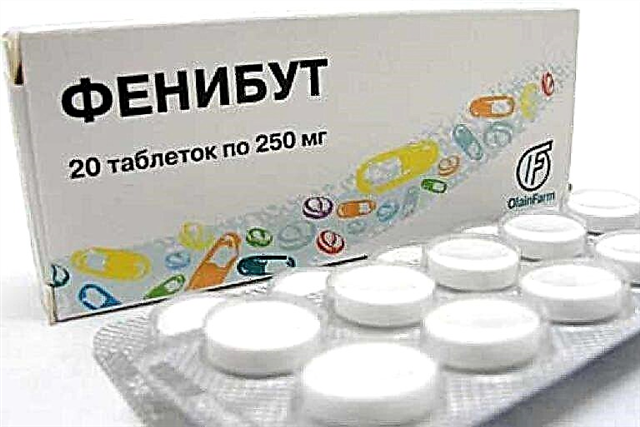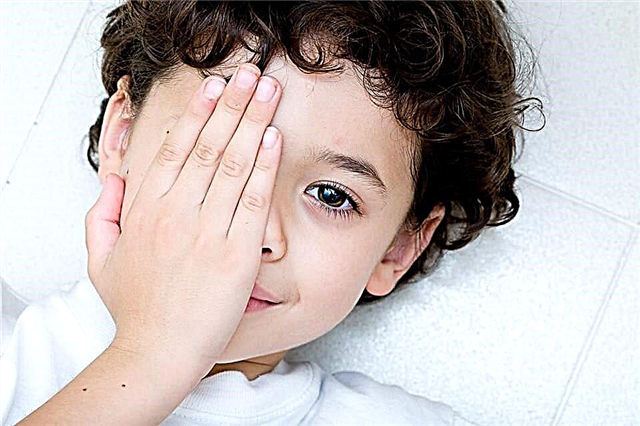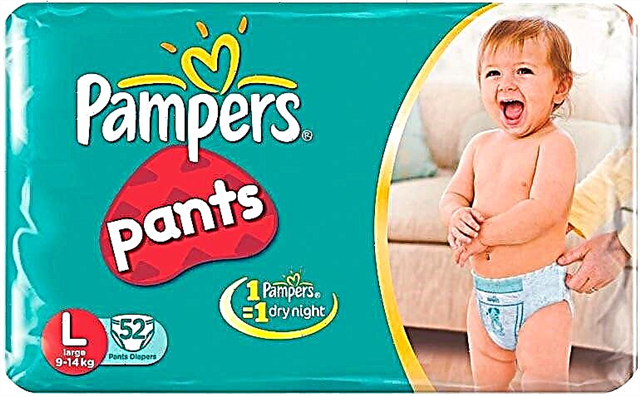Treating a common cold in young children is not an easy process. Its appearance gives the baby trouble: the state of health worsens, it is difficult for the child to suck, rinsing the nose causes discomfort in the baby. Often, instead of transparent mucus, white snot appears in a child. Parents mistakenly think that this is a complication of rhinitis. In fact, white thick snot in a baby can mean completely different problems.

Treatment of a common cold in a child is problematic and laborious
What does white snot mean
The appearance of snot in the nose of a small child indicates a violation. If the discharge is white and thick, then they indicate the onset of a cold. Also, such discharge can become a signal of the presence of an allergen in the body.
A runny nose is not a disease, but a symptom of an infection or other problem. If the mucus thickens and acquires a greenish tint, then there is a focus of infection in the body, the baby needs treatment.
On a note. It is very important for breastfed babies to eat their mother's milk, especially when they are sick. It contains an immunoglobulin that will help the baby fight infection. Even if the baby refuses to breast, you should try to feed him anyway.
Reasons for the appearance in babies
It is difficult to immediately understand the true cause of the appearance of white thick snot in a child. The factors that cause the appearance of a runny nose with white discharge are different. The child's condition is monitored, the general condition is assessed.
The reasons for the appearance of white snot from the baby's nose:
- ARVI. For 7 days during an illness, snot is normal. Then they disappear.
- Complication. If the child during the illness (rubella, measles, SARS, flu) did not receive proper treatment, then the runny nose can become lingering.
- Sinusitis. The first symptoms of the disease are precisely white snot.
- Pathology in the nasopharynx. If the baby has congenital curvature of the nasal septum or polyps in this area, then white discharge may appear regularly.
- Allergy. The body can respond to the presence of allergens in the form of nasal discharge.
- Caries on the teeth of the upper jaw. The bacterial flora easily moves to the nasal sinuses.
- Adenoids. Pathology proceeds with the active release of mucus from the nose.
- Rare infectious processes (cytomegalovirus and mononucleosis) are accompanied by the release of whitish mucus.
In addition to complex diseases, the cause of the appearance of such discharge may be a banal non-observance of the conditions of keeping the child. A runny nose can cause hypothermia or overheating, as well as low humidity. The optimum temperature is + 21-23 ° C with a humidity of at least 70%.
On a note. To increase humidity, you should use special devices or just periodically hang wet diapers around the room.

Often snot is triggered by teething
In small children up to six months, snot can be provoked by the eruption of the first teeth (60% of infants suffer from a runny nose for this reason), a complication during childbirth.
Why mucus turns white
The appearance of white discharge from the baby's nose indicates the penetration of an infection or irritant into the body. In children under one year old, the occurrence of discharge often indicates teething.
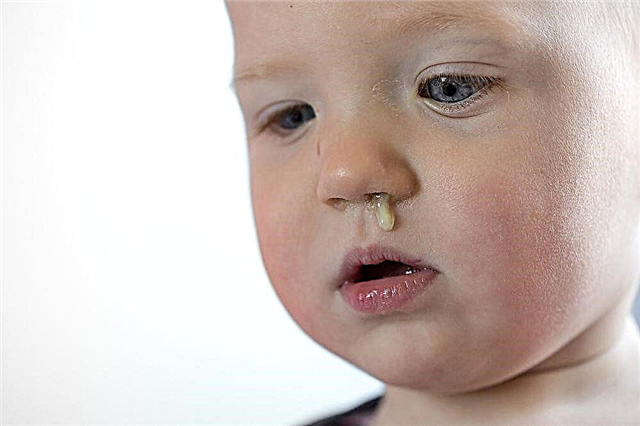
White cloudy snot can be the result of an untreated disease
Sometimes white snot can act as a complication after an illness. Microorganisms invade the sinuses, causing sinusitis.
By the appearance of the discharge, you can determine the type of disease, but only a doctor can diagnose and prescribe competent treatment.
Varieties in structure
The mucus that appears from the nose differs in structure and color:
- At the initial stages of the development of a viral infection, the discharge has a liquid consistency and a transparent color.
- The presence of allergens in the child's body is indicated by dense white mucus.
- In inflammatory processes of the upper respiratory tract of a chronic nature, mucus acquires a foamy structure and can change its color from white to yellow.
If the discharge of snot is accompanied by fever and other symptoms of diseases, then you need to call a doctor at home and follow his recommendations.
Varieties by nature of occurrence
White snot can occur for various reasons:
- Infectious rhinitis. It is caused by viruses, bacteria or fungi. In addition, fever, inflammation and other symptoms are observed.
- An allergic rhinitis is characterized by a white or cloudy thick discharge without fever and inflammation.
- Vasomotor type. It occurs under stress, dry air, too high or low temperature in the room.
- Traumatic rhinitis. Presented by the release of white secretion due to thinning of the mucous membranes.
- Medication type. It occurs with prolonged use of vasoconstrictor drugs, is a signal of addiction to drugs.
Knowing only the true cause of a cold, you can get rid of it. If you just remove the snot as a symptom, then they will appear again and again. You need to cure an infectious disease or remove an allergen.

Treatment of snot should begin with determining the cause.
Treatment features
Treatment of a cold in an infant at 1-2 months is not much different from therapy in a child after a year. The baby must be shown to the doctor. He will determine the cause of the disease, and then give his recommendations for treatment.
Drug treatment
First of all, the child needs to remove mucus. To quickly release mucus from the sinuses, you need:
- Create optimal conditions around the child.
- Rinse the baby's nose regularly and in a timely manner and remove mucus. Rinse the spout up to 6 times as needed.
- Support the child psychologically.
On a note. Up to a year, babies are not able to get rid of mucus on their own. Adults should remove secretions with a nasal aspirator or a rubber bulb. To facilitate the removal process, special moisturizing preparations, for example, in sea salt or saline solution, are instilled into the spout.
At night after cleansing, vasoconstrictor drugs are instilled into the nose. Depending on the type of disease and the condition of the child, the doctor may prescribe antihistamines, decongestants, antiviral drugs, antibiotics.
They follow all recommendations on nutrition, daily routine, optimal conditions in the room. Acquire prescribed vitamin complexes. Physiotherapy is sometimes recommended in addition to medication.
Traditional methods of treatment
If there is no fever, and the snot is white or yellowish, then you can try folk methods:
- A decoction of chamomile or calendula is instilled into a spout (1 teaspoon of dry grass is infused for 10 minutes in 200 ml of water in a steam bath). With this composition, 2 drops are dripped into the nose 4-5 times a day.
- Aloe juice is diluted with boiled water in a 1: 1 ratio. Instill 3 times a day, 2 drops.
When treating a cold in young children, you should not use essential oils, drops from onions, garlic and parsley. Such aggressive agents can cause allergies in a small child.

If there is an inhaler at home, then the procedures will help in the treatment of rhinitis.
For the duration of treatment, one cannot refuse to swim, provided that there is no temperature. Baby baths will be similar to inhalation.
The development of a cold
A runny nose has several stages of development. Each of them has its own characteristics:
- The appearance of transparent discharge, resembling water in consistency. Their occurrence suggests that the body is trying to remove the infection or allergen from the inside on its own.
- In the second stage, the discharge from the nose becomes milky white. The snot contains cells that died in the fight against the virus.
- The transition to the third stage indicates re-infection. If the body has not coped with the infection, and it has moved into the nasal cavity, then the color of the discharge becomes yellow or green, in consistency they are thick and viscous.
The first two stages most often proceed without fever, in the third, deterioration is more clearly noticeable.
Who to contact
If, in addition to white snot, there are no more symptoms of any diseases (fever and other signs of a viral infection), then treatment can be limited to washing at home.
Consultation with an otolaryngologist or pediatrician will be required if the color of the snot becomes yellow or greenish. The same doctors are consulted if the discharge does not stop for a long time (more than 7-10 days).
After examination, the doctor will establish a diagnosis. If the discharge is too thick and prolonged, then an X-ray will be prescribed to exclude sinusitis. If the picture shows a curvature of the nasal septum or other pathology, it will be referred to the surgeon. In some cases, a dentist's consultation is required.
On a note. When viscous white snot appears in newborns under one year old, a doctor's consultation is required. It is important to promptly eliminate the cause of the common cold, and not the symptom.
Possible complications
A runny nose itself is not a complex disease, it is a harmless symptom, but you should not expect that it will go away on its own. If there is no treatment for the disease that caused it, then serious unpleasant consequences may appear:
- the infection will spread to the ears and throat;
- a bacterial infection will join;
- inflamed sinuses;
- sinusitis is formed.
When a runny nose appears, the child's normal life is disrupted. The baby's snot, especially thick and white, interferes with breathing, sleeping and eating normally. Liquid snot irritates the skin around the nose. When breathing through the mouth, the mucous membranes dry out.
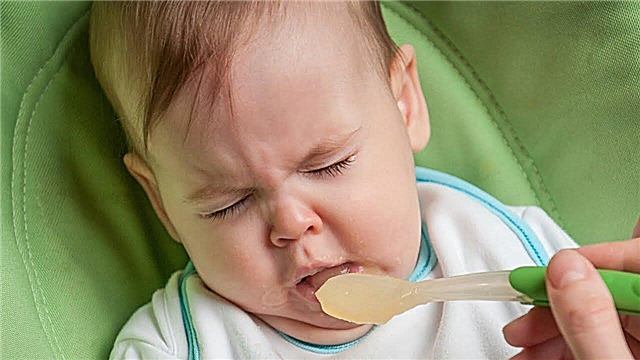
A runny nose makes life difficult for a baby, even eating is difficult
Recommendations for prevention
If you create favorable conditions around the child, as well as adhere to some of the recommendations of pediatricians, that is, the likelihood of completely eliminating the appearance of rhinitis in children under 1 year old:
- adhere to the planned correct daily routine;
- be in the fresh air more often;
- feed your baby the right healthy food;
- regularly air baths for the child;
- do daily gymnastics with the baby;
- regularly carry out wet wipes.
It is more difficult to treat rhinitis in a child than in an adult. The kid is not able to blow his nose on his own. Therefore, parents need to be patient so that the little nose breathes freely. With snot in the nose, it is not only difficult for a child to breathe, but even eating food causes him difficulties.

